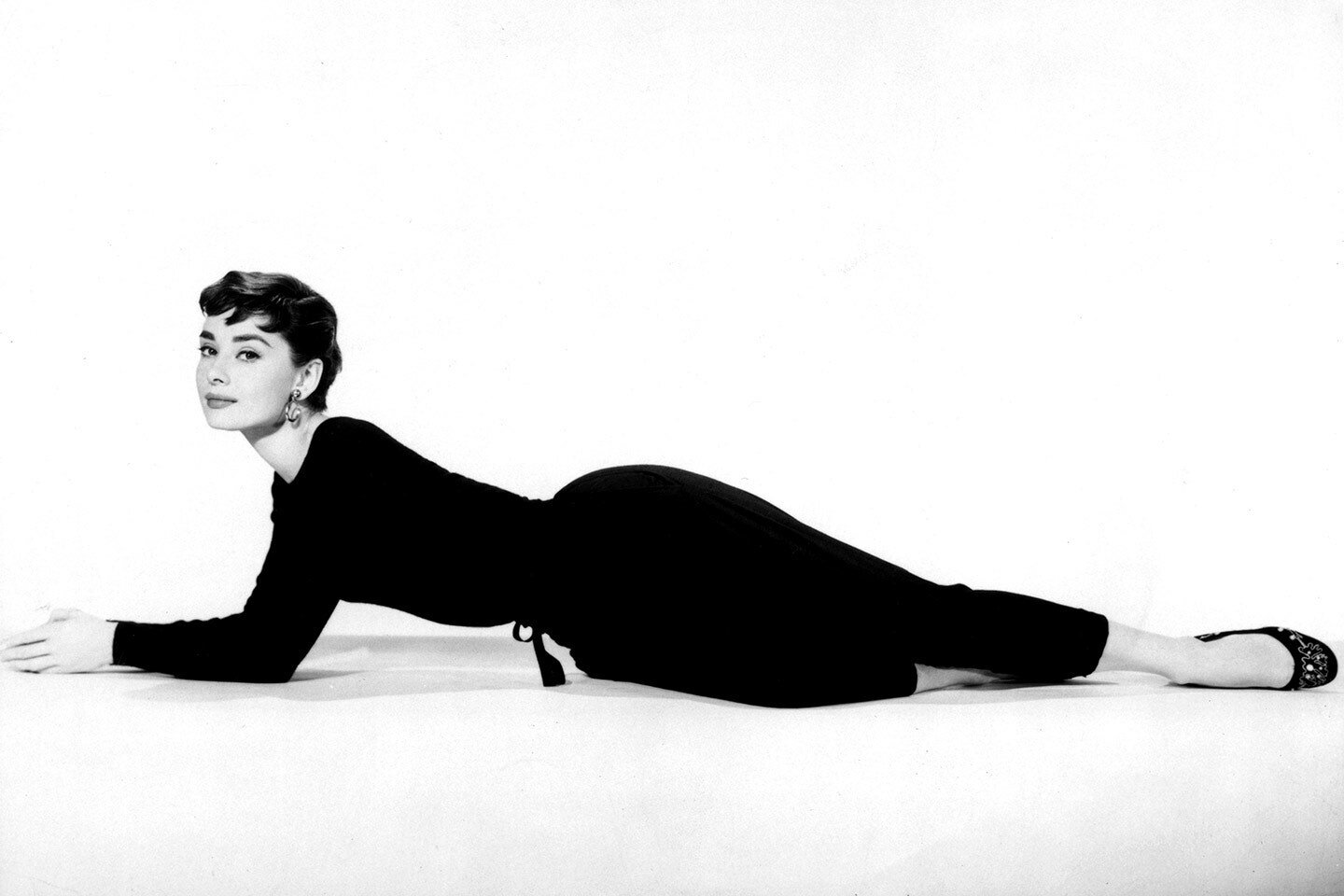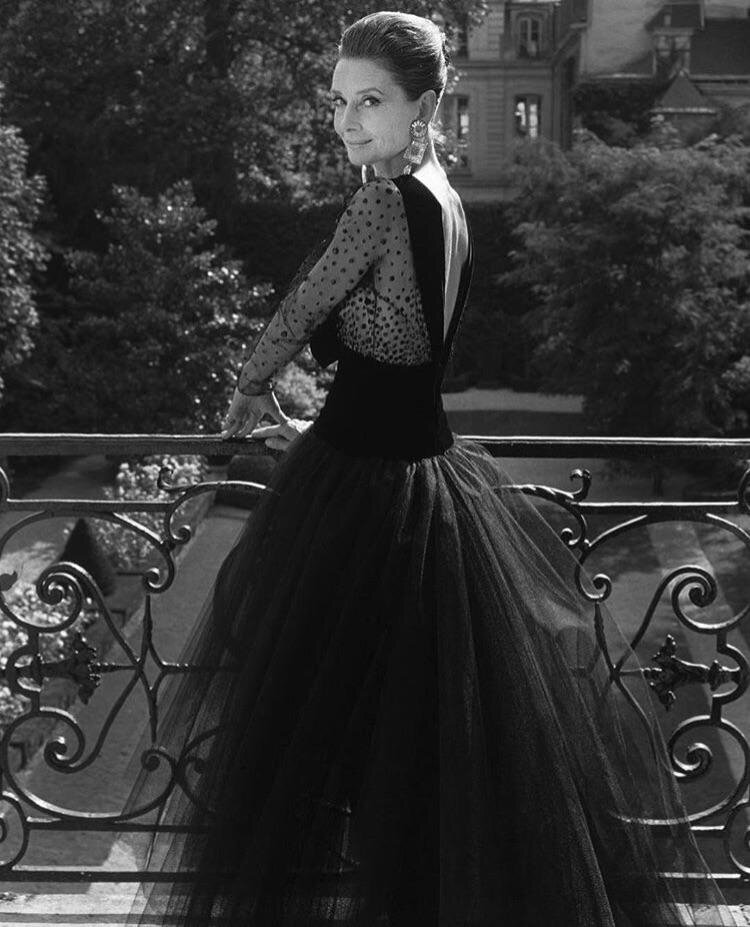Perhaps no style icon is as revered as Givenchy muse, humanitarian, and legendary actress Audrey Hepburn. Ranked by the American Film Institute as the third-greatest female screen legend in Golden Age Hollywood, Audrey is famously known for her role as Holly Golightly in Breakfast at Tiffany’s, but also other gems such as Roman Holiday (1953), Sabrina (1954) - our personal favorite, and Funny Face (1957). She’s also known for her lithe figure, and universal, unparalleled synonymity with elegance. And as always here at The Psychology of Fashion, we wonder: what made her this way? What was it about Audrey that made her so seemingly perfect, so achieving in so many domains, including fashion? Thanks to history, we know enough about Audrey through many biographies and facts to draw some conclusions. Here’s Audrey through the Big 5.
OPENNESS: Moderate
Audrey Hepburn married her first husband American actor and director Mel Ferrer in 1954 in a dress designed by Pierre Balmain.
The first key personality trait, openness, is defined by a person’s receptivity to new ideas and experiences, general open-mindedness, and how traditional or unconventional they are. This trait is often gauged by one’s life choices. We’re going to put Audrey squarely in the middle here. She always yearned to be a mother and have a family. "When I get married, I want to be really married", she once said in a press release. And married she was - three times, and gave birth to two sons - Sean Hepburn Ferrer and Luca Dotti. Yet at the same time, she was a fiercely independent woman for her time. Audrey was extremely motivated to succeed as a dancer from a young age and bought her own home, La Paisable, in Tolochenaz, Switzerland. She had animals. She was outspoken about injustice and became a humanitarian way before it was newsworthy.
Using fashion psychology, we see this balance in her personal style. There is certainly an element of the conservative - Audrey was often in a simple boat neck, a slim pant, and ballet flats. She was never dishevelled, or flashy. You certainly couldn’t call Ms Hepburn bohemian. But then there was her relationship with Hubert de Givenchy, which gave away her preference for the modern, the avant-garde. Mr de Givenchy was first hired to design her on-screen wardrobe for her second Hollywood film Sabrina, when she was still unknown as a film actor and he a young couturier just starting his fashion house. Audrey fell in love with his chic sense of simplicity, and Givenchy went on to make most of her clothes both on and off-screen thereafter. We can thank Audrey for making the house what it is today.
CONSCIENTIOUSNESS: High
Audrey Hepburn with Hubert de Givenchy in his workshop in Paris. (Photo: Corbis, via Getty Images.)
We think it’s pretty clear that Audrey Hepburn was one very disciplined lady. During her lifetime, she won a Tony, Grammy, Emmy, and Oscar, which has only been achieved by a handful of others. People who score high on conscientiousness are typically orderly, neat, and rigorous about meeting their goals, whereas people who score lower on conscientiousness are more likely to be laid-back and free-spirited. Those who score highly on conscientiousness tend to be high achievers in terms of worldly success. Hepburn started her career as a ballet dancer, training in London with Marie Rambert after World War II. She went on to find fame as an actress and a humanitarian, but she retained her dancer’s poise and posture her whole life. Admitting that she her slim figure was one of her key draws as an actress at the time, she spoke of how she would allow herself to eat precisely one square of dark baking chocolate every day as a treat. She remained exactly as she was, poised, principled throughout her life and her high conscientousness is clear in her never-failing polished, immaculate appearance.
EXTROVERSION: Moderate-Low
Audrey brooding in Paris, a city that seemed to personify her.
Despite her most famous character Holly Golightly depicting the quintessential New York City socialite, Audrey herself was more of an introvert. Why else make a home in a remote Swiss village and retreat there as often as you can? Those who score high on extroversion tend to derive their energy from being around others and tend to always seek out people when they’re feeling down. Introverts prefer to go inward. Audrey had once famously said: “When the chips are down, you are alone, and loneliness can be terrifying. Fortunately, I've always had a chum I could call. And I love to be alone. It doesn't bother me one bit.” In another quote, she had said “I'd be quite happy if I spent from Saturday night until Monday morning alone in my apartment. That's how I refuel." So there’s that. And this low-extroversion can be seen in her personal style. Audrey Hepburn was known for simplicity and dressing in neutrals, never anything to purposely draw attention to her, nothing too decorous, flamboyant or ornate.
AGREEABLENESS: Moderate
Audrey Hepburn with Bimba the Donkey at the Villa Rolli, Cecchina, 23 June, 1955.
Highly agreeable people tend to be kind, peaceful, and value getting along with others, whereas people who score lower on this trait are more prone to voice their opinions, even if it means getting into conflict. We think Audrey held a nice balance in the trait of agreeableness. We’ve never come across any data alluding that Audrey was anything less than gracious, nice and polite to everyone who encountered her. When Audrey died in 1993 at the age of 63, following 5 years of intense humanitarian work, it was clear that we lost a woman of great compassion. On her UNICEF appointment as Goodwill Ambassador, she stated that she was grateful for receiving international aid after enduring the German occupation as a child, and wanted to show her gratitude to the organization. On the other hand, Audrey was no pushover. She spoke out bravely about her difficult childhood during the war and about all the unjustness she saw in the world. Stylistically, her fashion choices confirmed a balance in the trait of agreeableness as well. Audrey’s style was elegant and approachable, there was nothing brash or aggressive about it, and yet it wasn’t over-the-top feminine. In line with her no-bullshit approach, she favored black, simplicity and clean lines. No frou.
NEUROTICISM: Moderate-High
Audrey Hepburn, 62, photographed by Jean-Claude Sauer in a gown by Givenchy to celebrate the fashion house’s 40th anniversary in 1991.
“I was born with an enormous need for affection, and a terrible need to give it”, Audrey once said. Spoken like a person who is sensitive, a sub-trait of neuroticism, Audrey lived in a way that betrayed an emotional, vulnerable heart. Neuroticism gets a bad rep, high quantities of it are correlated with anxiety and low moods, but it’s a trait that also makes us passionate, creative and sensitive to the needs of others. Low scorers are lucky in that they are more prone to positive moods and cheerfulness, and they tend to be analytical, but are less inclined to be artistic. People who have a deep appreciation of fashion as life’s armor, and the protective color of black in particular, tend to score higher on neuroticism, and well, the proof is in the pudding with Ms Hepburn, who lives up to the meaning of both ‘fashion icon’ and ‘artist’ in spades.
Take the test below to find out your own Big 5 scores.
















We use the ‘Driver’s License’ singer’s sartorial style to infer where she would score on the Big Five Personality test.